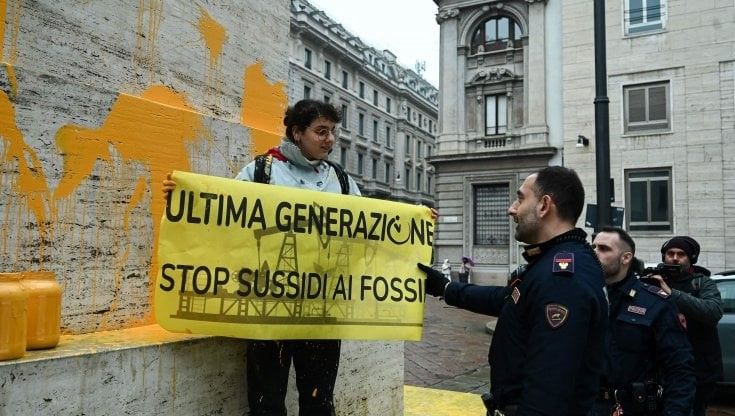YELLOW IS THE COLOUR I HAVE ALWAYS LOVED
By Ultima Generazione

“Yellow is the colour I have always loved.” With this comment by artist Maurizio Cattelan, the debate on the choice of Italian climate justice movement ‘Ultima Generazione’ to ‚target‘ artworks for many of its acts of non-violent civil disobedience, is concluded. One could ask if it had ever officially begun. It is always useful to reiterate, also for those who still categorically prefer to say the opposite, that these acts have not damaged any paintings, art installations and buildings, the latter being daubed in washable paint. While certain Italian cultural circles and associations linked to the protection of the artistic and historical heritage were scandalised and indignant towards the methods used by the young members of Ultima Generazione (even invoking severe and exemplary punishments), some wondered, with less bitterness and more cultural curiosity, what the authors of the works of art in question would have thought of what was quickly and banally labelled an ‚act of vandalism‘. The likes of Van Gogh, Botticelli, Andy Warhol, and others. When it comes to dead and historic artists, one can only use one‘s imagination. Although it’s nice to imagine Vincent Van Gogh, who died in poverty and solitude, sitting next to these guys today, waiting to be taken away by force to the nearest police station. Indignant and disappointed at how the ferocity of capitalism has, in our time, reduced that field he painted being ploughed at sunset to an asphalt footpath, a space covered by expanses of ground-mounted photovoltaic installations or dug up to illegally bury carcinogenic industrial waste, or even ceded for decades to agribusiness multinationals that, instead of crop biodiversity, plant endless soya and hazelnut groves. In the case of Cattelan‘s Carrara marble installation ‘L.O.V.E.’, located in front of Milan‘s Palazzo Mezzanotte (Stock Exchange) and the target of a campaign by Ultima Generazione on 15 January 15th, the artist’s thoughts arrived almost in real time.
In fact, choosing to display a hand with four fingers severed, leaving only the middle one in a truncated imaginary Roman salute to the contemporary fascism represented today by the financial and industrial world of the stock exchanges, is consistent with Ultima Generazione’s message and campaigning slogans: ‘Make them pay’ and ‘Stop Fossil Fuels’. On the physical and virtual stock exchanges, private capitalism continues to invest only in fossil fuels; sustained by truckloads of euros in environmentally harmful public funding. In Italy alone, this amounted to €41.8 billion in 2021 (see Legambiente Report).
An industrial, economic and financial world, which then, in the most blatant acts of greenwashing, ‚cleans its conscience‘ with acts of philanthropy and cultural patronage, supporting public, national and international museums, art galleries, and funding large exhibitions for tourism purposes. This is a subtle, and creeping, progressive form of ‚privatisation‘ where this capital replaces the ever decreasing options for public investment in cultural and artistic heritage and ‘allows’ prestigious museums, even internationally renowned ones, to stay open despite the costs of maintenance, activities, staff and improving their collections.
This is what has been happening in Europe and the United States for several years now, where the sponsors are always the most important fossil fuel companies: Shell, Total, BP, and the very Italian ENI. Or, when not directly sponsored by the companies, it’s the so-called ‚armed banks‘ (in the sense that they lend their services to the arms industry) that perform the same function, at least in Italy. Intesa Sanpaolo and Unicredit for example, which are also among the world‘s most important credit institutions for investments in the fossil fuel industry. It is obvious that such a ‘heavy‘ presence of private entities in the sphere of cultural support distorts the function of ‚public service’ and the real role of a museum or an art gallery.
It is no coincidence that this can be seen in the small and medium-sized civic institutions in the Italian provinces, that haven’t necessarily reached metropolitan or international dimensions, where museum activities or cultural events have for some time been less and less thought out and planned and no longer have the cultural growth of a community as their mission. The final recipient has overwhelmingly become the tourist rather than the citizen. This produces a progressive civil and cultural impoverishment of local communities, contributes little to the GDP of a region and often leaves behind environmental and landscape damage. The tourism industry, about which Marco D‘Eramo in an essay published by Feltrinelli entitled ‚Il selfie del mondo. Indagine sull‘età del turismo’ (Selfie of the world. Investigation into the era of tourism), describes with bitter realism the consequences, is a strong cause of pollution ‚of land, sky and sea‘. Instead of a civilised growth of individuals and societies, it produces only a strong cultural disorientation. One need only think of the multitudes of tourists dumped ashore by cruise liners and ‘dropped off‘ for flash visits to museums, galleries, archaeological sites, etc. People who, more often than not, won’t even remember the name of the museum or historic home they visited a few hours later.
Large cruise carriers, who are trying to rebuild their corporate ‚virginity‘ by aligning themselves with the deceptive concept of ‚ecological transition‘. The most recent example is that of the new MSC Crociere ad, which in some respects seems almost satirical. The tourism giant, which was founded in Naples but has long had its legal and financial HQ in Switzerland, is keen to give the impression that it has undergone a real ecological conversion in its latest promotional narrative. First it ‚confesses‘ the reasons why it is a big polluter (emissions, fuel, junk food served on board, energy and light expenditure, noise, discharges, etc.), then it wonders if cruises will ever be able to achieve ‘net zero’ in terms of emissions, claiming that MSC will nevertheless manage it. But instead of listing the practical and credible choices it has made that are already in place, it concludes by saying the company continues to ask the question. As if the solution belonged to some third party, extraneous to the company. Therefore, when one thinks of the world of Ultima Generazione, and other related movements that fight for climate justice, and sets aside the filters and lenses that view them as an ‚unhealthy‘ generational other, as well as any historic or political prejudices fossilised in the 20th century, it means finding out about the cultural, iconographic and value-based meanings behind the choices and actions of this movement.
Which is capable, beyond its specific mission, of putting the relationship that should be reconstructed between cultural policy and people‘s civil growth, precisely because of the social function that culture represents for a community and region, back at the heart of the public debate. And calls on public institutions return to their role as the main guarantors and supporters of culture. It doesn’t demonise private patronage but doesn’t assume it has the function of ‚decisionmaker‘ as a result of its economic weight. It’s also about knowing how to choose. This is the challenge, also from an ethical point of view. The private ‚money‘ in question should not be the product of any capitalism that is about to make planet Earth uninhabitable for the human species.
Ethical choice has almost been completely abandoned in the public cultural field and left to the good will, and often courage, of the individual artist or author. A small episode that happened a few months ago in the field of literature is significant in this regard. The protagonists were Angelo Ferracuti, one of the most important Italian authors and Giovanni Marrozzini, an internationally renowned photographer. In September 2022, their book, ‚VIAGGIO SUL FIUME MONDO Amazzonia‘, was published by Mondadori; a reportage documenting how the Amazon and its peoples were threatened by loggers, gold prospectors and multinational oil companies. In October, they should have received the ‚Pages of the Earth’ literary prize in Venice after being entered ex officio by their publishing house. A prestigious prize awarded by an important jury (which included, among others, Gennaro Sangiuliano, Ermete Realacci, Marco Frittella, Carlo Vanzina). Just a few days before they realised that the main sponsor of the competition was ENI. A company that continues to drill, invest in gas, that has for years produced biodiesel by exploiting the Amazon rainforest and that is Italy‘s main emitter of greenhouse gases. As a result, Ferracuti and Marrozzini chose not to accept the award (which also included a significant cheque). A good example of radicalism. Which should, however, also stimulate engagement in new and different public responsibilities.
Part of an international network called A22, Ultima Generazione was formed in 2021 and practices non-violent civil disobedience actions to obtain measures against ecoclimatic collapse. The organisation’s manifesto reads: ‘We are the last generation of the old world. We are in the last hour, the darkest hour. This world is being decimated before our eyes. We are here to force governments to drastically reduce carbon emissions, nothing else. We are here for action, not words’. In recent months they have been much talked about for ‘daubing’ works of art in museums and squares, a desperate cry for answers to the environmental crisis.
